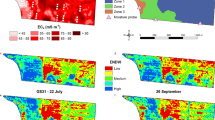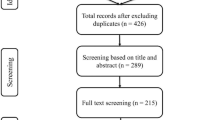Abstract
High spectral resolution spectroscopy enables to have detailed information on chemical and morphological status of crop. An attempt of using space platform for detecting red edge shift during different growth stages of wheat crop is reported. Study was conducted during rabi 1996–97 season using Modular Opto-Electronic Scanner MOS-B Imaging data onboard IRS-P3 satellite. Inverted Gaussian model was fitted for satellite derived reflectances between 650 and 870 nm to derive inflection wavelength and its subsequent change with crop stages i.e. red shift. Red shift of 10 nm observed from crown root initiation stage (703.8 nm) to peak vegetative stage (714.2 nm). A comparative study on temporal behaviour of vegetative indices like NDVI and ARVI with Red edge showed that latter is more atmospherically stable parameter. It is concluded that red edge shift which hitherto has been observed from ground and airborne sensors, can also be detected from space.
Similar content being viewed by others
References
Bannari A, Morin D, Bonn F and Hurte A R (1995). A Review of Vegetation Indices, Remote Sensing Reviews, 13, 95–120.
Bonham-Carter G F (1987). Numerical procedures and computer program for fitting and Inverted Gaussian Model to vegetative reflectance data. Computers and Geoscience, 14(3):339–356.
Boochs F, Kupfer G, Dockter and Kuhbauch W (1990). Shape of the red edge as vitality indicator for plants, In Remote Sensing, 11(11):1741–1753.
Buker C, Clever J G P W and Kuhbauch W (1992). Measuring the intensity of nitrogen fertilization of grassland by means of remote sensing, In Proc. of the central sympo. of the international space year conference. Munich, Germany. March 30–April 4, 1992, CESA SP-341, 689.
Demetriades-Shah T H and Steven M D (1988). High spectral resolution indices for monitoring crop growth and chlorosis. Proc. of the 9th Int. Colloquium of Spectral Signatures of the Objects in Remote Sensing in Aussois., France on 10–22 Jan. 1988, ESA SP-287, 299–302.
Guyot G, Feret F and Jacquemoud S (1992). Imaging Spectroscopy for vegetation studies, Imaging Spectroscopy In: Fundamentals and Prospective Applications (Eds. T. Tosseli and Bodechtel), Kluwer Academic Publishers, pp. 145–165.
Gitelson A A, Merzlyak M N and Lichtenthaler K (1996). Detection of red edge position and chlorophyll content in reflectance measurement, J. Plant Physiol., 148, 501–508.
Kaufman Y J and Tanre D (1992). Atmospherically Resistant Vegetation Index (ARVI) for EOSMODIS.IEEE Trans. Geoscience and Remote Sensing, 30(2):261–270.
McCalla T R (1967). Introduction to numerical methods and FORTRAN programming: John Wiley and Sons, New York, 359 p.
Slater P N (1980). Remote Sensing, Optics and Optical System, Addison-Wesley Publishing Company, Reading, Massachusetts.
Author information
Authors and Affiliations
About this article
Cite this article
Singh, R., Oza, S. & Dadhwal, V. Observations on temporal red shift of wheat from multi-date spaceborne MOS-B spectrometer data. J Indian Soc Remote Sens 26, 45–56 (1998). https://doi.org/10.1007/BF03007339
Received:
Accepted:
Issue Date:
DOI: https://doi.org/10.1007/BF03007339




